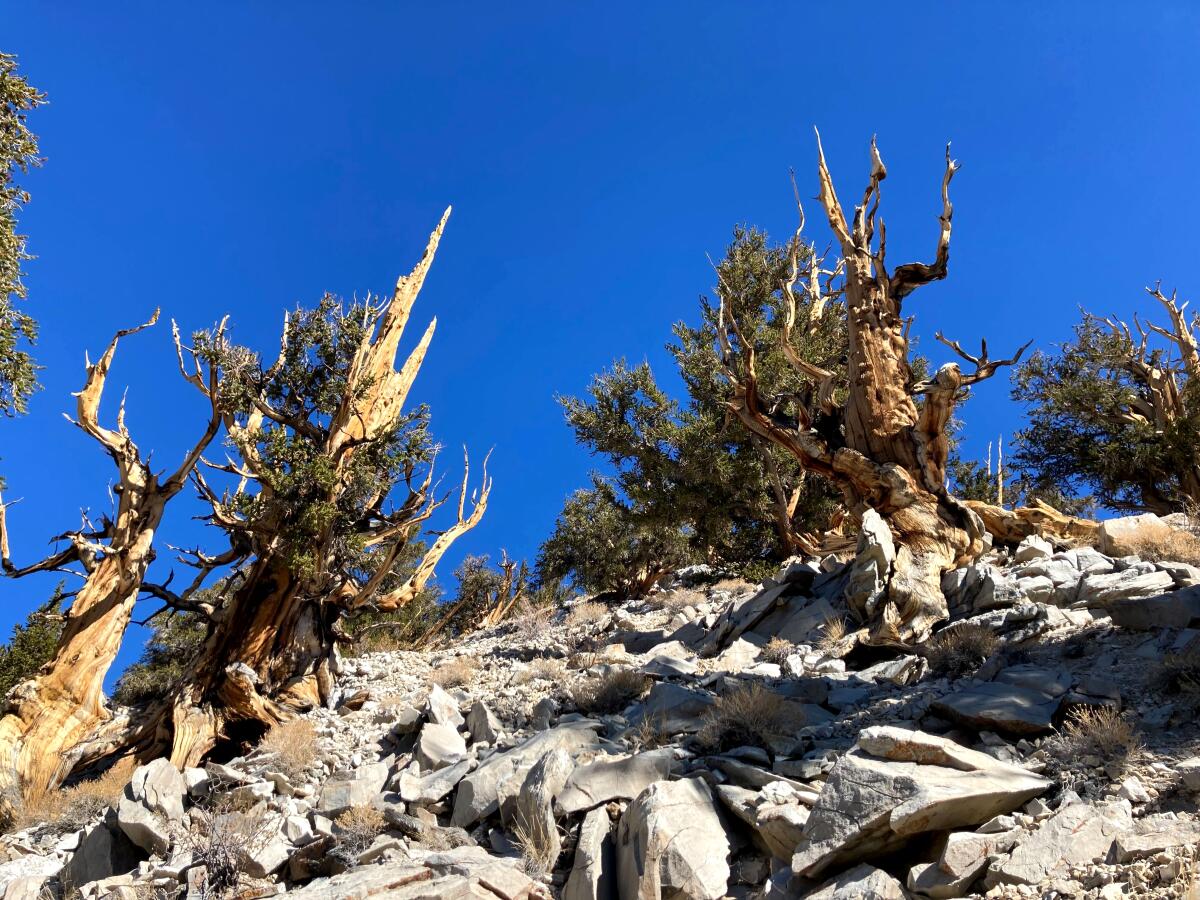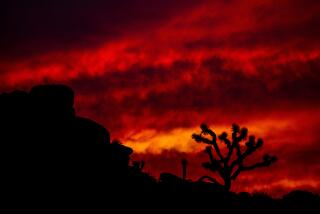Commentary: Will Methuselah, a tree standing for nearly 5,000 years, survive modern humanity’s ravages?

While every responsible citizen was fixated on election returns this week, my mind was high on a mountainside almost midway up California’s border with Nevada. It was there, last October at roughly 10,000 feet elevation, that I celebrated my 40th birthday with Methuselah, a 4,853-year-old Great Basin bristlecone pine tree.
Methuselah is the oldest known living organism on Earth. For years I had wanted to visit this ancient tree, commune with it and ponder all the human history, the empires and egos it silently outlasted, as it eked out its meager, frigid existence on rock and soil that could barely sustain more flora than its neighboring bristlecone pines. More importantly, my body had recently (and without warning) accelerated its aging process, and what better way to begin my fifth decade with some healthy perspective than by mingling with the planet’s most grizzled veterans?
But in setting my birthday resolution — to stand next to the oldest tree on the planet — I might have been a bit mistaken. Last month, there was news among dendrochronologists that researchers in Chile believe an ancient cypress there known as Gran Abuelo may be 5,400 years old, which, if confirmed, would beat Methuselah by about six centuries.
But for the time being, at least until Gran Abuelo’s age is verified, Methuselah remains the oldest, though even what counts as “oldest” is debatable. Other “clonal” specimens — a colony of genetically identical aspens in Utah growing from a single underground parent root, for example — have existed for more than 10,000 years. Near Methuselah in the White Mountains, a researcher claimed to have found another bristlecone pine older than 5,000 years. He refused to say which tree that was, and in 2013 he took that secret to his grave.
As with that mystery tree, the exact location of Methuselah is kept secret by researchers, for good reason. Notable trees in California often become tourist attractions, a fate that’s wonderful for boosting environmental awareness but terrible for the specimens themselves. In the 1930s, a car tunnel was dug out of the magnificent Chandelier tree, a stunning redwood that reaches almost 300 feet high and sits near California’s northwest coast. Though that tree remains alive, similarly defaced coastal redwoods and giant sequoias elsewhere in California have weakened to the point of death.
So it’s no surprise that the precise location of another notable California redwood — Hyperion, the world’s tallest known tree — is known primarily to certain researchers and government workers, as is the case with Methuselah. It’s also why Chilean conservationists and government officials should do everything in their power to stop Gran Abuelo from being loved to death — slowly chipped away by souvenir seekers or turned into a drive-through tunnel.
Through some photo research, I believe I’ve been able to find Methuselah. But I could be wrong, and even if I’m right, I wouldn’t disclose its location. Methuselah and even less spectacularly ancient trees are what humans inherit from the natural world, and their survival (or not) betrays how sustainable or out of balance our civilization is. Already, we see groves of giant sequoias that survived fire and drought for 3,000 years imperiled by a few summers of climate change-driven wildfires. Ancient bristlecone pines stand a better chance of continued existence amid longer droughts and warmer temperatures, but there are signs that climate-driven plant migrations may shrink their habitat.
Trees like Methuselah survive for millennia largely because of their remoteness. Their decline would be the ultimate indicator of how severely humanity has altered nature. You might not be able to see Methuselah with your own eyes — or at least know when you’re looking at it — but that tree’s ability to survive should matter to you.
And, of course, this doesn’t account for direct damage to these trees. One bristlecone specimen, confirmed to have lived longer than Methuselah, named Prometheus, was cut down in the 1960s by a researcher who was trying to recover his jammed boring tool. The stone-colored, lifeless stump of Prometheus still sits off a high mountain trail in Nevada’s Great Basin National Park.
If Methuselah is officially dethroned as the planet’s most senior resident, then I suppose the reduced public attention will be all the better for its survival. I will feel no less in awe of that otherworldly arid landscape and its gnarled inhabitants.
Long live Methuselah, and long live Gran Abuelo. With global warming unleashing catastrophic change on the planet’s 3 trillion trees, they’ll need our help — and our restraint — to continue outlasting human civilizations.
More to Read
A cure for the common opinion
Get thought-provoking perspectives with our weekly newsletter.
You may occasionally receive promotional content from the Los Angeles Times.











